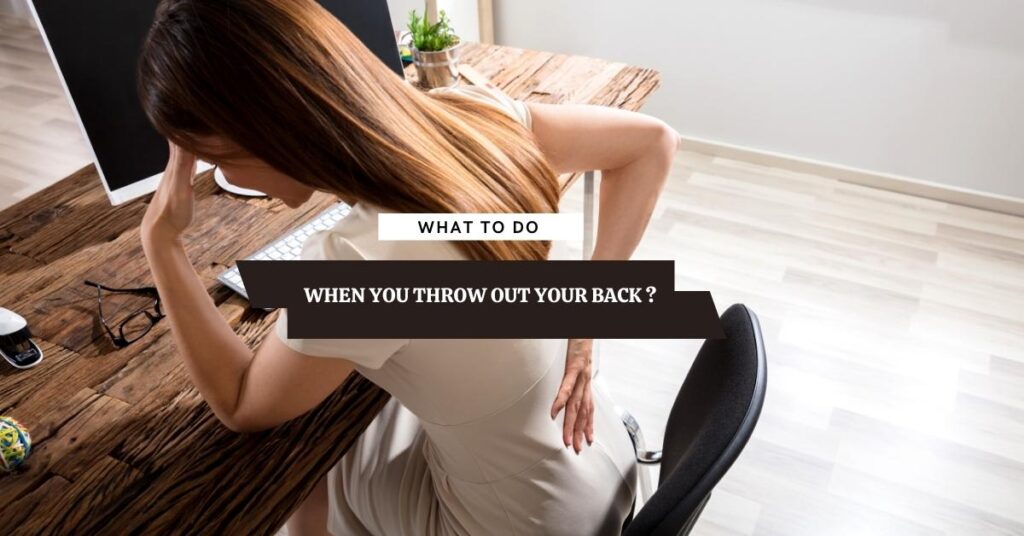When you throw out your back, the pain can be excruciating and making even the smallest movement difficult. It’s important to take care of yourself when you have thrown out your back, because if left untreated, it can become even more painful and debilitating.
Whether you are experiencing mild or acute back pain, there are some steps you can take to make yourself more comfortable and increase the chances of making a full recovery quickly. Read on to learn how to take care of yourself when you’ve thrown out your back.

#1 Sleep in A Good Position
The best position for sleeping is on your side with a pillow between your knees. When sleeping on your side, make sure that you keep as much of your body off of the mattress as possible. You also may want to use a small body pillow between your legs and torso to support yourself through the night. This way, if one side of your lower back becomes sore during sleep, there’s another part of you that can take some pressure off while not interfering with any natural sleep movements.
#2 Take a Cold Shower
It may seem counterintuitive, but a cold shower can help relieve pain and muscle tension in your back. This is because cold water increases blood flow, which helps decrease swelling and soothe aches and pains. Plus, cold showers have been proven to reduce anxiety by stimulating serotonin production—and reduced anxiety means less muscle tension. So instead of getting that massage or taking a pill, try stepping into a freezing shower (yes, it will hurt at first) for 30 seconds to one minute each day.
#3 Massage Your Lower Back
A lot of people think that massage therapy is only used for increasing blood flow and reducing pain in musculoskeletal problems. In reality, massage has been proven to improve overall health by stimulating blood flow through a process called vasodilation. By improving blood flow, it’s easier for oxygen and nutrients to reach the tissues and aid in tissue repair or regeneration.
#4 Take an Advil
While medication won’t heal your damaged discs, an Advil (ibuprofen) may make it more comfortable for you to walk and move around. Always consult with a physician if you have concerns about taking painkillers regularly. Tylenol (acetaminophen) is another option that’s effective but non-steroidal—meaning it won’t irritate other issues like ibuprofen may.
#5 Stand Up Slowly
You might feel like crawling around on all fours, but remember that moving slowly and carefully helps to avoid putting additional pressure on your back. Try standing up using a stable chair for assistance, and be sure not to bend over at any point during the process. Instead, work with a doctor on ways to strengthen your core muscles so that in future instances you’ll be able to move more easily.
#6 Ice and Heat
Applying ice is a good way to manage inflammation and keep down swelling. Start by applying an ice pack or a bag of frozen peas wrapped in a towel, or holding it against painful areas of your back. Although everyone’s favorite strategy for treating an aching back is to chill it out with ice, there are also therapeutic benefits to heat. Studies show that alternating between heat and cold can reduce pain more effectively than either treatment on its own, so try putting on a heating pad after applying some ice. Just remember: Heat helps muscles relax, so use caution if you have any residual soreness in your back—it could lead to an overexertion injury.
# 7 Try Coffee or Tea
If you can’t sleep because of a bad back, try some hot coffee or tea. It may not be particularly relaxing, but it will put something warm in your stomach and take away some of that hunger—and being hungry is what often leads to throwing out your back.
#8 Rest on the Floor
Lying flat on your back will keep any pressure off of your spine and let it heal. If you are unable to lie down, sit in a chair with both feet on the floor and hands supporting your lower back. Another option is a recliner that supports good posture while sitting, or leaning against a wall.
#10 Get a help from Chiropractor
When you’re in pain, all you want is relief, and if that means an anti-inflammatory and muscle relaxer from chiropractor [1] or even an over-the-counter medication, then so be it.
Chiropractic care, especially, over these years have been quite helpful for people of all ages and backgrounds. Are you thinking, how much does it cost to go to a chiropractor ? Well, there are many different types of chiropractic care and much depends upon the experience of the practitioner and facility, so choose one that will best suit your needs. In fact, a recent study found that almost 70% of respondents reported improved quality of life due to their chiropractor’s treatment for back pain.
#11 Spinal Injections
When other therapies (like over-the-counter pain relievers and physical therapy) fail, some people are tempted to turn to injections for relief. There are several types of injections, including epidural steroid injections, which may be done in a doctor’s office. These steroids numb nerve endings and provide instant pain relief. However, these injections often have complications with swelling or infection so should be used only as a last resort. Apart from that, dry needling, like many physical therapy modalities, might also be a secure way to lessen your back pain.
#12 Antidepressant Medications
When suffering from acute back pain, some people may be tempted to use antidepressant medications. While antidepressant drugs are typically prescribed for depression and other mental illnesses, they may also offer relief for muscle and joint pain.
How long does it take for a thrown out back to heal?
A thrown-out, or hyper-extended, back takes a long time to heal. This can be frustrating and even painful, especially if you’re not sure what steps to take. It’s important to ease into things once your doctor says it’s OK. If you attempt anything too strenuous too soon, it may put undue pressure on an already inflamed area and delay healing altogether.
Does walking help a thrown out back?
Although throwing out a muscle or ligament is painful, it does not affect mobility. In fact, walking and other forms of exercise can help speed up recovery. However, if walking causes pain, don’t force yourself; give yourself time to rest and recover from an injury like any smart human would.

Lifebing is driven by an unrelenting passion for promoting health and well-being, our team is wholly committed to curating exceptional content and immersive experiences.
